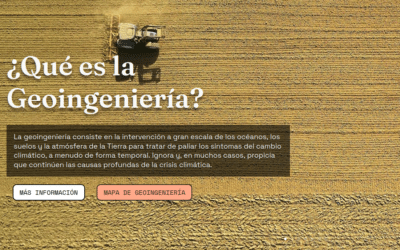
Workers on Germany’s highest mountain, Zugspitze, cover the glacier with oversized plastic sheets to keep it from melting during the summer months. Scientist have said geoengineering must be researched to find a possible solution of last resort to dangerous levels of global warming. Photograph: Matthias Schrader/AP
But ‘geoengineers’ say urgent nature of climate change means research must continue into controversial technology to combat rising temperatures
This was originally published by the Guardian
by Damian Carrington
Fighting global warming by reflecting sunlight back into space risks “terrifying” consequences including droughts and conflicts, according to three major new analyses of the promise and perils of geoengineering. But research into deliberately interfering with the climate system must continue in search of technology to use as a last resort in combating climate change, scientists have concluded.
Billions of people would suffer worse floods and droughts if technology was used to block warming sunlight, the research found. Technology that sucks carbon dioxide from the air was less risky, the analysis concluded, but will take many more decades to develop and take effect.
The carbon emissions that cause climate change are continuing to rise and, without sharp cuts, the world is set for “severe, widespread, and irreversible impacts”. This has led some to propose geoengineering but others have warned that unforeseen impacts of global-scale action to try to counteract warming could make the situation worse.
Matthew Watson, at the University of Bristol, who led one of the studies in the £5m research programme, said: “We are sleepwalking to a disaster with climate change. Cutting emissions is undoubtedly the thing we should be focusing on but it seems to be failing. Although geoengineering is terrifying to many people, and I include myself in this, [its feasibility and safety] are questions that have to be answered.”
Watson led the Stratospheric Particle Injection for Climate Engineering (Spice) project, which abandoned controversial attempts to test spraying droplets into the atmosphere from a balloon in 2012. But he said on Wednesday: “We will have to go outside eventually. There are just some things you cannot do in the lab.”
Prof Steve Rayner at the University of Oxford, who led the Climate Geoengineering Governance project, said the research showed geoengineering was “neither a magic bullet nor a Pandora’s box”.
But he said global security would be threatened unless an international treaty was agreed to oversee any sun-blocking projects. “For example, if India had put sulphate particles into the stratosphere, even as a test, two years before the recent floods in Pakistan, no one would ever persuade Pakistan that that had not caused the floods.”
The researchers examined two types of geoengineering, solar radiation management (SRM) and carbon dioxide removal (CDR). Prof Piers Forster, at the University of Leeds, led a project using in-computer models to assess six types of SRM. All reduced temperatures but all also worsened floods or droughts for 25%-65% of the global population, compared to the expected impact of climate change:
- mimicking a volcano by spraying sulphate particles high into the atmosphere to block sunlight adversely affected 2.8bn people
- spraying salt water above the oceans to whiten low clouds and reflect sunlight adversely affected 3bn people
- thinning high cirrus clouds to allow more heat to escape Earth adversely affected 2.4bn people
- generating microbubbles on the ocean surface to whiten it and reflect more sunlight adversely affected 2bn people
- covering all deserts in shiny material adversely affected 4.1bn people
- growing shinier crops adversely affected 1.4bn people
The adverse effect on rainfall results from changed differences in temperature between the oceans and land, which disrupts atmospheric circulation, particularly the monsoons over the very populous nations in SE Asia. Nonetheless, Forster said: “Because the [climate change] situation is so urgent, we do have to investigate the possibilities of geoengineering.”
Rayner said SRM could probably be done within two decades, but was difficult to govern and the side effects would be damaging. He noted that SRM does not remove carbon from the air, so only masks climate change. “People decry doing SRM as a band aid, but band aids are useful when you are healing,” he said.
In contrast, CDR tackles the root of the climate change problem by taking CO2 out of the atmosphere, would be much easier to govern and would have relatively few side effects. But Rayner said it will take multiple decades to develop CDR technologies and decades more for the CO2 reductions to produce a cooling effect. “You are going to have to build an industry to reverse engineer 200 years of fossil fuel industry, and on the same huge scale,” he said.
The recent landmark report by the UN Intergovernmental Panel on Climate Change (IPCC), signed off by 194 governments, placed strong emphasis on a potential technology called bioenergy carbon capture and storage (BECCS) as a way to pull CO2 from the atmosphere. It would involve burning plants and trees, which grow by taking CO2 from the air, in power plants and then capturing the CO2 exhaust and burying it underground.
“But if you are going to do BECCS, you are going to have to grow an awful lot of trees and the impact on land use may have very significant effects on food security,” said Rayner. He added that the potential costs of both SRM or CDR were very high and, if the costs of damaging side effects were included, looked much more expensive than cutting carbon emissions at source.
Both Watson and Rayner said the international goal of keeping warming below the “dangerous” level of 2C would only be possible with some form of geoengineering and that research into such technology should continue.
“If we found any [geoengineering] technology was safe, affordable and effective that could be part of a toolkit we could use to combat climate change,” said Rayner.
“If we ever deploy SRM in anger it will be the clearest indication yet that we have failed as planetary guardians,” said Watson. “It [would be] a watershed, fundamentally changing the way 7bn people interact with the world.”



